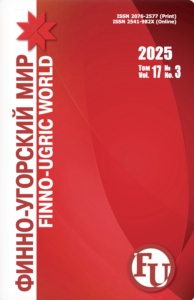Lelkhova Fedosya M.,
Candidate Sc. {Philology}, Leading Research Fellow, Ob-Ugric Institute of Applied Research and Development (Khanty-Mansiysk, Russia), lelhovafm@yandex.ru
Introduction. The relevance of the research topic is determined by the insufficient knowledge of the lexico-semantic group of verbs in dialects of the Khanty language; this group of motion verbs was not the object of special research. The verbs of this semantics were not considered in a comparative aspect. The paper makes the classification of these verbs in the English and Turkic languages: Chuvash, Tatar, Tuvan, and Uzbek. The subject of the study is the lexico-semantic group of verbs of figurative characteristics of the movement of the Khanty language. The goal of the study is to identify and describe the verbs with the meaning of the image characteristics of the movement in the Synskij dialect.
Materials and Methods. Based on the dialect of the Khanty language, the article considers the lexico-semantic group of verbs of the figurative characteristic of motion.
Results and Discussion. The classification of verbs of figurative characteristics of motion in the Synskij dialect of the Khanty language is presented for the first time. We have identified 5 verbs in the semantics of which the figurative component is incorporated: hrjõytti ‘grab by the arm (or by the collar) and drag by force, carry on quickly, drag along, carry awayʼ; lўnity, ‘drag along, go slowlyʼ, ‘go as a person wearing wet clothesʼ, ‘go as a drunk manʼ; posyjty ‘go somehowʼ, ‘walk unwillingly, with lazinessʼ; shihrjemәty ‘go around shufflingʼ; shhivrjemәty ‘to walk, shufflingʼ. These verbs are not combined with adverbial modifier meaning action.
Conclusion. It touches upon about 17 varieties of figurative meanings, which are transmitted by special means, namely phraseological expressions, combinations of verbs with verbal participles, adverbs, verbal preverbs. The groups of figurative verbs of the Khanty language are compared with similar units in the Nenets and some Turkic languages; it reveals the meaning specific to the Khanty language with the figurative semantics: meaning of human movement, moving by making frequent steps / large steps; rapid movement; movement of the kolobok (rolling); meaning ‘go bent’; onomatopoeia, etc.
Key words: Khanty language; verb; meaning; descriptive characteristic of motion; sema; motion.
For citation: Lelkhova FM. Glagoly obraznoj harakteristiki dvizhenija v hantyjskom jazyke (na materiale synskogo dialekta) [Verbs of figurative characteristics of movement in the Khanty language (on the basis of the Synskij dialect)]. Finno-ugorskiy mir = Finno-Ugric World. 2017; 1: 6–16. (In Russ.)
- Barys-Khoo VS. Leksiko-semanticheskaja gruppa glagolov dvizhenija v tuvinskom jazyke (v sopostavitel’nom aspekte). Dis. …kand. filol. nauk [Lexico-semantic group of verbs of motion in Tuvan language (in comparative aspect). Ph. D. philol. sci. dis.]. Novosibirsk; 2006. (In Russ.)
- Butorin SS. Direktivnye glagol’nye satellity v ketskom jazyke i tipologija modelej leksikalizacii L. Talmi [Directive verbal satellites in the Ket language and typology of lexicalization models by L. Talmy]. Vestnik Tomskogo gosudarstvennogo pedagogicheskogo universiteta = Bulletin of Tomsk State Pedagogical University. 2012; 1: 33–37. (In Russ.)
- Valgamova SI. Dialektologicheskij slovar’ hantyjskogo jazyka (shuryshkarskij i priural’skij dialekty) [Dialectological dictionary of the Khanty language (Shuryshkar and Urals dialects)]. Ekaterinburg: Basco; 2011. (In Russ.)
- Vasilieva TN. Glagoly dvizhenija v sovremennom chuvashskom jazyke. Dis. … kand. filol. nauk [Verbs of movement in the modern Chuvash language. Ph. D. philol. sci. dis.]. Cheboksary; 1980. (In Russ.)
- Ishtanova RK. Glagoly tatarskogo jazyka v semanticheskom aspekte. Dis. … kand. filol. nauk [Verbs of the Tatar language in the semantic aspect. Ph. D. philol. sci. dis.]. Kazan; 2002. (In Russ.)
- Lelkhova FM. Slovar’ glagolov hantyjskogo jazyka (shuryshkarskij dialekt) [Dictionary of verbs of the Khanty language (Shurishkar dialect)]. Khanty-Mansiysk: Izdatel’skij dom “Novosti Jugry”; 2012. (In Russ.)
- Maysak TA. Tipologija grammatikalizacii konstrukcij s glagolami dvizhenija i glagolami pozicii [Typology of grammar constructions with verbs of motion and verbs of position]. Moskva: Jazyki slavjanskih kul’tur; 2005. (In Russ.)
- Noskova MV. Kognitivnye osnovanija funkcionirovanija leksiko-semanticheskoj gruppy glagolov, oboznachajushhih maneru dvizhenija (na materiale anglijskogo jazyka) [Cognitive bases of the functioning of the lexical-semantic group of verbs denoting the manner of motion (on the material of the English language)]. Novye vozmozhnosti obshhenija: dostizhenija lingvistiki, perevodovedenija i tehnologii prepodavanija jazykov: materialy mezhdunar. nauch.-prakt. konf.= New possibilities of communication: achievements in linguistics, translation and technology of teaching languages: Conference proceedings. Irkutsk; 2011: 147–153. (In Russ.)
- Panov VA. K tipologii i diahronii glagolov dvizhenija v latinskom jazyke [On typology and diachrony of verbs of movement in Latin. Available from: http://www.Iling-ran.ru 11.pdf (accessed 22.10.2016). (In Russ.)
- Solovar VN. Hantyjsko-russkij slovar’ (kazymskij dialekt) [Khanty-Russian Dictionary (Kazym dialect)]. Tyumen: Format LLC; 2014. (In Russ.)
- Chugunekova AN. Glagoly dvizhenija i formiruemye imi modeli prostogo predlozhenija (na materiale hakasskogo jazyka). Avtoref. dis. … kand. filol. nauk [Verbs of motion and models of a simple sentence formed by them (on the material of the Khakass language). Abstract of Ph. D. philol. sci. dis.]. Novosibirsk; 1998. (In Russ.)
- Shilova VV. Prostranstvennye modeli jelementarnyh prostyh predlozhenij v neneckom jazyke [Spatial models of elementary simple sentences in the Nenets language]. Novosibirsk; 2003; 1. (In Russ.)






















